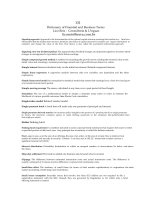Applications of Robotics and Artificial Intelligence Part 14 ppsx
Bạn đang xem bản rút gọn của tài liệu. Xem và tải ngay bản đầy đủ của tài liệu tại đây (25.29 KB, 16 trang )
APPLICATIONS OF ROBOTICS AND ARTIFICIAL INTELLIGENCE
Get any book for free on: www.Abika.com
261
Vision Sensors
16. Current commercial systems are
restricted to binary image and simple
features; gray-scale and color are
available today only in very restrictive
form
17. 3-D vision systems, structured light,
and stereo approaches to acquiring depth
image are rudimentary and only beginning to
emerge from laboratories into commercial
systems
VLSI implementation now in labs will be
commercialized. This will facilitate edge
images from gray-scale data, and richer
feature sets will be developed
Laboratory systems of several varieties
will be commercially available. They will
produce depth maps in controlled
situations, but they will be slow, will
produce noisy images, and have limited
resolution. They will permit 3-D surface
inspection and will discriminate objects
with large shape differences
Systems that permit rapid recognition and
provide orientation of limited classes of
objects from arbitrary points of view
APPLICATIONS OF ROBOTICS AND ARTIFICIAL INTELLIGENCE
Get any book for free on: www.Abika.com
262
Reliable hardware for depth images and
systems for tracking and recognizing moving
objects
Contact and Tactile Sensing
18. Few robots have force or tactile
sensors. The IBM RSI is an exception.
Limited use of commercialized RCC and IRCC
versions of Draper Research products
provide limited control capacity at present
Force-sensing wrists and techniques for
programming and controlling force will be
available. They are likely to work only in
benign situations, but should be able to
tighten nuts, insert shafts, pack objects
simple assembly operations. Will not yet be
good enough to examine objects by feeling
them
Well-established techniques for creating
and using these sensors will be developed.
Determining shape of objects, detecting
slippage in grip, inspecting for cracks,
and programming in the force domain will be
possible. Touch sensors will be implemented
in hardware, probably using VLSI
technology. This will permit all of the
above and offer a wider range of force
monitoring and compliant operations
Now In 5 Years In 10 Years
APPLICATIONS OF ROBOTICS AND ARTIFICIAL INTELLIGENCE
Get any book for free on: www.Abika.com
263
Artificial Intelligence
19. Expert systems that work effectively in
providing competent analysis within a
narrow area of expertise,
e.g. oil exploration, medical diagnosis,
VLSI design, are being customized and
commercialized. They are limited by a
narrow body of simple interactions, and
they take a single perspective on the
problem. There are no generalized ways to
build the expert systems
20. Natural-language data base access
methodology is limited to single-shot query
systems for specific data bases. Some
require restricted subsets of English
grammar, but others are more general about
input. Commercial systems are just starting
to appear
Automated design assistance for building
and updating expert systems. Formalization
of knowledge gathering and integration of
graphic displays for use in some
applications. Integration with robot
control systems and sensors to provide
controlled expertise for limited domains,
e.g., arc welding
APPLICATIONS OF ROBOTICS AND ARTIFICIAL INTELLIGENCE
Get any book for free on: www.Abika.com
264
New sophisticated dialog capabilities for
interactive sessions will appear. Some
developments will permit the start of
natural-language data bases. The connection
of expert systems to natural language will
begin
Integrated systems that draw on multiple
domains of expertise to formulate problem
solutions. Possibly total automation in
generating new expert systems for certain
domains . Self-diagnosing and limited
repair of electronic equipment limited
repair of electronic equipment
The hard line between natural-language
query and expert systems will disappear.
Systems will be integrated, but the domain
of knowledge will still be restrictive
21. Automated assistants research is now
going on in a variety of tasks, such as
word processing, text editing, and office
automation ion
22. Knowledge representation in restricted
domains is now workable (see entries 19-
21). But learning, problem-solving, and
planning systems need broader domains .
Systems that assist and familiarize users
with the capabilities of the system being
used
APPLICATIONS OF ROBOTICS AND ARTIFICIAL INTELLIGENCE
Get any book for free on: www.Abika.com
265
Increased understanding of tradeoffs
between domain-independent and domain-
dependent techniques
Integrated systems that draw on multiple
domains and provide the user with with
greater task flexibility
Possibly a notation system that allows
formulation of models that are sensitive to
domain constraints without having specific
commitments to particular domains
Control Structure/Programming Methodology
23. The control hierarchy of robots
sometimes implemented on multiple
microprocessors has at most 5 levels now.
1. Servo control of joints
2. Coordinate transformation and
coordinated joint motion.
3. Interpolated path planning for smooth
motion paths.
Individual elements of progress (not all in
any one offering) will be developed.
. Graphical layout of robotic cells and
programming will be commercialized
APPLICATIONS OF ROBOTICS AND ARTIFICIAL INTELLIGENCE
Get any book for free on: www.Abika.com
266
. Hierarchical task-oriented interface
languages designed for process planners
will be developed .
Levels six and seven as defined in the
previous column will permit domain-
dependent , sensor-based intelligent
robots. Many integration issues and
advances to technology will still be open
questions. Robotics will broaden in scope
beyond manufacturing to limited-domain
automatic devices in new areas.
Now In 5 Years In 10 Years
4. Simple subroutines, use of sensors, and
lock-step coordination
5. Rudimentary operating system, structural
language, complex sensor interface,
hierarchical constructs
. Robot operating systems will do more for
the user who uses sensors to permit task
orientation
. Interfaces to other nonhomogeneous
computers will broaden coordination beyond
lock-step available now
. Multiple arm, dexterous hand, locomotive
control, and other new mechanical advances
APPLICATIONS OF ROBOTICS AND ARTIFICIAL INTELLIGENCE
Get any book for free on: www.Abika.com
267
will define a sixth level of control and be
available
. The incorporation of AI technology in the
form of expert systems, natural-language
front ends) and knowledge representation
will define a seventh level of control.
. Data bases from CAD, CAM) and other
sources will be incorporated to the
language and control structure
REFERENCES
1.
National Bureau of Standards. 1980.
Proceedings of NBS/Air Force ICAM Workshop
on Robot Interfaces, June 4-6. NBSIR 80-
2152.
2. Taylor, R. H., P. D. Summers, and J. M.
Meyer. 1982. AML: A Manufacturing Language.
International Journal of Robotics Research
l(3):19-41.
3. Birk, J. and R. Kelley, eds. 1980.
Research Needed to Advance
APPLICATIONS OF ROBOTICS AND ARTIFICIAL INTELLIGENCE
Get any book for free on: www.Abika.com
268
the State of Knowledge in Robotics.
Kingston: Rhode Island
University.
4. Roth, B. Kinematic Design for
Manipulation, in [3], pp. 110-118.
5. Dubowsky, S. Dynamics for Manipulation,
in [3], pp. 119-128.
6. Houston, R. Compliance in Manipulation
Links and Joints, in [3], pp. 129-145.
7. Paul, R. P. 1981. Robot Manipulators
Mathematics Programming
and Control. Cambridge, Mass.: MIT Press.
8. Brady, M. and J. Hollerbach. 1982. Robot
Motion: Planning and
Control. Cambridge, Mass.: MIT Press.
9. Toepperwein, L. L., M. T. Blackmon, R.
Fukui, W. T. Park, and B. Pollard. 1980.
ICAM Robotics Applications Guide. Vol. II.
Technical Report AFWAL-TR-80-4042.
10. Salisbury, J. K. and J. Craig. 1982.
Articulated Hands: Force
Control and Kinematic Issues. International
Journal of Robotics
APPLICATIONS OF ROBOTICS AND ARTIFICIAL INTELLIGENCE
Get any book for free on: www.Abika.com
269
Research l(l):4-17.
11. Hollerbach, J. M. 1982. Workshop on
Dexterous Hands. MIT AI Memo.
12.
Orin, D. E. 1982. Supervisory Control of a
Multilegged Robot. International Journal of
Robotics Research 1(1):79-91.
13. Gleason, G. J. and G. Again. 1979. A
Modular Vision System For Sensor Control
Manipulation and Inspection. SRI Report,
Project 4391. SRI International.
14. Lavin, M. A. and L. I. Lieberman. 1982.
AML/V: An Industrial Machine Vision System.
International Journal of Robotics Research
1(3):42-56.
15. Nagel, R. N., et al. 1979. Experiments
in Part Acquisition
Using Robot Vision. SME Technical Paper MS
79-784.
16. Brady, M. 1982. Computational
Approaches to Image Understanding.
Computing Surveys 14:4-71.
17. Nevins, J. L., et al. Exploratory
Research in Industrial Assembly and Part
APPLICATIONS OF ROBOTICS AND ARTIFICIAL INTELLIGENCE
Get any book for free on: www.Abika.com
270
Mating. Report No. R-1276. Cambridge,
Mass.:
Charles Stark Draper Laboratory. 193 pp.
18. Harmon, L. D. 1982. Automated Tactile
Sensing. International Journal of Robotics
Research 1(2):3-32.
19. Bejczy, A. K. 1979. Manipulator Control
Automation Using Smart Sensors. Paper
delivered at Electro/79 Conference, New
York, April 24-26.
20. Raibert, M. H. and J. E. Tanner. 1982.
Design and Analysis of a VLSI Tactile
Sensor. International Journal of Robotics
Research. l(3):3-18.
21. Hillis, W. D. 1982. A High Resolution
Image Touch Sensor. International Journal
of Robotics Research. l(2):33-44.
22. Albus, J. S., A. J. Barbera, M. L.
Fitzgerald, R. N. Nagel, G. J.
VanderBrug, and T. E. Wheatley. 1980.
Measurement and Control
Model for Adaptive Robots. Pp. 447-466 in
Proceedings, 10th
International Symposium on Industrial
Robots, Milan, Italy, March
APPLICATIONS OF ROBOTICS AND ARTIFICIAL INTELLIGENCE
Get any book for free on: www.Abika.com
271
5-7.
23.
Nagel, R. N., et al. 1982. Connecting the
Puma Robot With the
MIC Vision System and Other Sensors.
Pp.447-466 in Robot VI
Conference Proceedings, Detroit, March 2-4.
24. D. R. Brown, et al. 1982. R&D Plan for
Army Applications of AI/Robotics. SRI
Project 3736. SRI International. 324 pp.
25.
Nau, D. S. 1982. Expert Computer Systems
and Their Applicability to Automated
Manufacturing. NBSIR 81-2466.
26.
Charniak, E., and Y. Wilks, eds. 1976.
Computational Semantics:
An Introduction to Artificial Intelligence
and Natural Language
Comprehension. Amsterdam: North Holland
Publishing Co.
27. Lehnert, W., and M. Ringle, eds. 1982.
Strategies for Natural
APPLICATIONS OF ROBOTICS AND ARTIFICIAL INTELLIGENCE
Get any book for free on: www.Abika.com
272
Language Processing. Hillsdale, N.J.:
Lawrence Erlbaum
Associates.
28. Nilsson, N. J. 1971. Problem Solving
Methods in Artificial
Intelligence. New York: McGraw-Hill.
29.
Schank, R., and R. Abelson. 1977. Scripts,
Plans, Goals and Understanding. Hillsdale,
N.J.: Lawrence Erlbaum Associates.
30. Waltz, D. L. 1982. Artificial
Intelligence. Scientific American.
247(4):118-133.
31. Winston, P. H. 1977. Artificial
Intelligence. Reading, Pa.:
Addison Wesley.
32. Proceedings for the Conference on
Applied Natural Language Processing, Santa
Monica, Calif., February 1983.
33. Proceedings for the Association of
Artificial Intelligence Conference on
Artificial Intelligence (IJCAI 1969, 1973,
1975, 1977, 1979, 1981).
APPLICATIONS OF ROBOTICS AND ARTIFICIAL INTELLIGENCE
Get any book for free on: www.Abika.com
273
34. Ballard, D. H. and C. M. Brown. 1982.
Computer Vision. Englewood Cliffs, N.J.:
Prentice-Hall.
35. Rosenfeld, A. 1983. Picture Processing:
1982. Computer Science Technical Report.
College Park: University of Maryland.
36. Dennicoff, M. 1982. Robotics in Japan.
Washington, D.C Office of Naval Research.
37. Raibert, M., and J. Craig. 1981. Hybrid
Controller. IEEE Systems Management
Cybernetics.
38. Barr, A., and E. A. Feigenbaum, eds.
1981, 1982. Handbook of Artificial
Intelligence, vols. I-III. Stanford,
Calif.:
HeurisTech Press.
39. State of the Art of Vision in Japan,
IEEE Computer Magazine (13)
1980.
GLOSSARY OF ACRONYMS
AFOSR Air Force Office of Scientific Research
AI artificial intelligence
AML manufacturing language developed at IBM
AMRDC U.S. Army Medical Research and Development Command
ASB Army Science Board
APPLICATIONS OF ROBOTICS AND ARTIFICIAL INTELLIGENCE
Get any book for free on: www.Abika.com
274
ASP Automated Ammunition Supply Point
ATE automatic test equipment
BITE built-in test equipment
C3I command, control, communication, and intelligence
CAD/CAM computer-aided design and manufacturing
CAI computer-aided instruction
CARP computer-aided robot programming
CMU Carnegie-Mellon University
CPU central processing unit
CRT cathode ray tube
DARPA Defense Advanced Research Projects Agency
DART expert system for the diagnosis of equipment failure
DEC Digital Equipment Corporation
DMA Defense Mapping Agency
ES expert system
FLIR forward-looking infrared
FMS flexible manufacturing system
GE General Electric Company
GM General Motors Corporation
Hawk-Missile CAI trainer at Fort Bliss Air Defense School
ICAM Integrated Computer-Aided Manufacturing program of the U.S. Air Force
IR industrial robot
IRCC instrumented remote center of compliance developed at Draper
Laboratories
JPL Jet Propulsion Laboratory
MACSYMA symbolic mathematics expert system
APPLICATIONS OF ROBOTICS AND ARTIFICIAL INTELLIGENCE
Get any book for free on: www.Abika.com
275
MIC
MIT
MYCIN
NBC
NBS
NSF
ONR
Prospector
PUFF
P3I
RAIL
RAMS
R&D
REMBASS
RIA
RPI
SAR
SRI
VAL
VHF
VHSIC
VIMAD
VLSI
VTRONICS
computer language developed at McDonnell Douglas
APPLICATIONS OF ROBOTICS AND ARTIFICIAL INTELLIGENCE
Get any book for free on: www.Abika.com
276
Machine Intelligence Corporation Massachusetts Institute of Technology
production system for diagnosis and treatment
of infectious diseases nuclear, biological) and chemical National Bureau of
Standards National Science Foundation Office of Naval Research
expert system to aid in exploration for minerals
pulmonary function diagnosis expert system preplanned product improvement
Pascal-based second generation language by IBM reliability, availability,
maintainability)
and supportability research and development
remotely monitored battlefield sensor system Robot Institute of America
Rensselaer Polytechnic Institute synthetic aperture radar Stanford Research
Institute
language developed by Unimation for Puma robot very high frequency
Very High Speed Integrated Circuits Voice Interactive Maintenance Assistance
Development system (supported by DARPA) very large-scale integration
set of projects for onboard, embedded sensing of vehicular malfunctions with
built-in test equipment (BITE)









